Jonathan Panzo, who plies his trade at Dijon FCO, the side that currently sits at the bottom of Ligue 1, has had an eventful start to life as a professional footballer. The 20-year-old is a product of Chelsea’s youth academy but he left the west London club to join AS Monaco in the summer of 2018. He remained a Monaco player until this past summer when he joined Dijon but spent the 2019/20 campaign away from Stade Louis II, on loan at Belgian side Cercle Brugge.
Despite Dijon’s struggles in Ligue 1 this term, plenty of other European clubs, such as Liga NOS leaders Sporting CP and Serie A side Udinese, are said to be keeping a close eye on the former Chelsea man, whose ambitious nature is evident in that last summer, he declared that he sees himself “playing for one of the big teams” in Europe in two to three years.
The 2020/21 campaign has been something of a mixed bag for Panzo. In addition to his team’s struggles, the Englishman has found himself out of favour at Stade Gaston Gérard, playing in just one of Les Hiboux’s last nine league games after starting regularly in the first half of the season. However, when he has had a chance to show what he can do this term, Panzo has made a strong account for himself and backed up his self-confidence.
In this tactical analysis piece, in the form of a scout report, we’ll provide analysis of Panzo’s performances this season. We’ll assess the key strengths and weaknesses of the 20-year-old’s game and look at how his side’s tactics might utilise him most effectively.
Positioning
As mentioned in the intro to this tactical analysis piece, the 185cm (6’1”), 71kg (158lbs) 20-year-old is a centre-back. He is left-footed and plays on the left side of Dijon’s backline, usually alongside veteran centre-back Bruno Ecuele Manga and left-back Ngonda Muzinga.
In the majority of their games this season, Les Hiboux have lined up in a 4-2-3-1 shape, though they have also utilised a 4-3-3 on occasion. In Ligue 1, Dijon have exclusively lined up with a four-man backline this term.
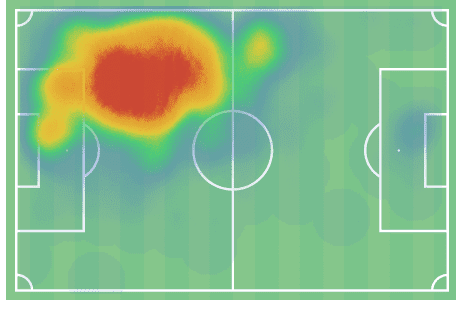
The image above shows us Panzo’s heatmap for the 2020/21 campaign, which provides further clarification on the exact areas that he typically occupies on the pitch.
This heatmap shows a considerable amount of colour out as far as the left sideline, which indicates that Panzo doesn’t just remain centrally, but also pushes out into wider positions at times.
We see Panzo move into wider positions on and off the ball. He pushes out wide during the build-up at times to give himself a better passing angle, while he often provides cover out wide for Muzinga off the ball, which sees him run out into a position you might associate more with the left-back. He has shown that he is comfortable with defending in central areas and wide areas.
Panzo’s defensive qualities
Now, we’ll take a closer look at the centre-back’s defensive qualities. In this section, we’ll look at how Panzo fares in defensive duels, as well as how often he engages in them, his ability to read the game and how it helps him to make a lot of interceptions, how much pace Panzo possesses and his aerial ability.
Firstly, we’ll provide analysis of Panzo’s reading of the game, which we feel is one of his strongest assets.
This season, Panzo has made 7.73 interceptions per 90, which is the seventh-most interceptions per 90 that any player has made in Ligue 1 this term.
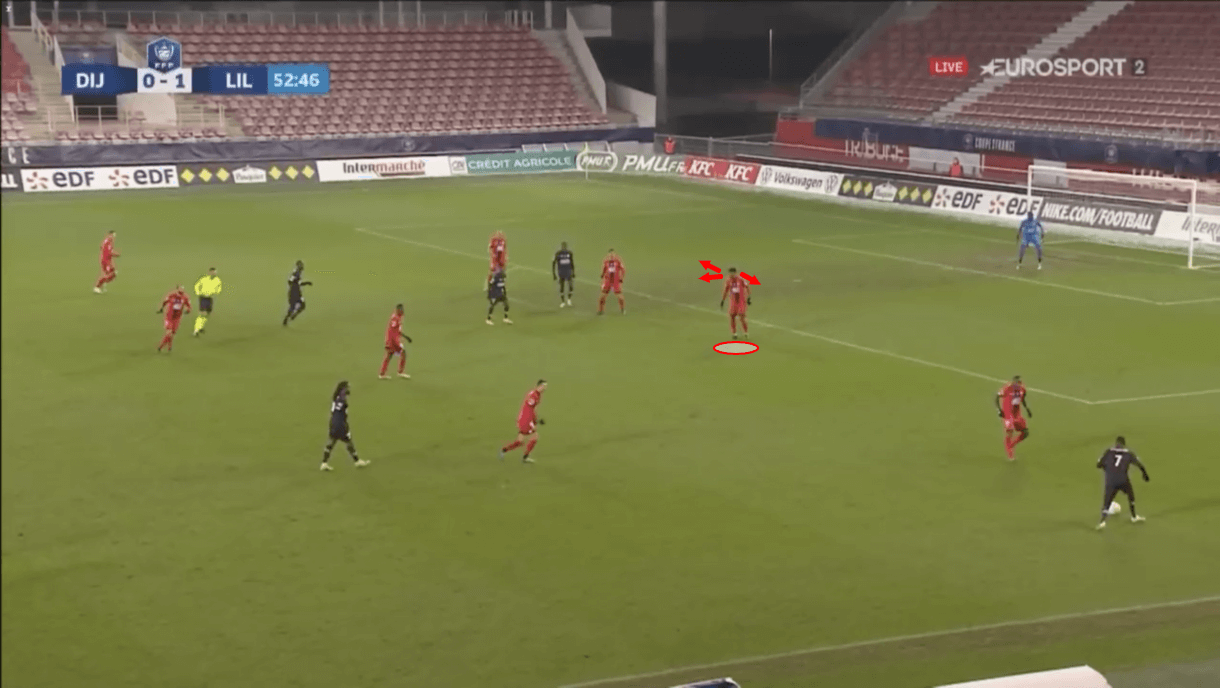
The image above shows us an example of one occasion where Panzo’s ability to read the game and assess danger paid off for Dijon, as he pulled off a vital interception. Here, we can see the centre-back positioned just on the edge of his penalty area, with Lille’s number ‘7’, Jonathan Bamba, in possession on the left-wing. As Bamba approaches Dijon’s box, Panzo can be seen checking his shoulders, anticipating what runs the Lille attackers are likely to make and watching Bamba’s movements to anticipate his next move.
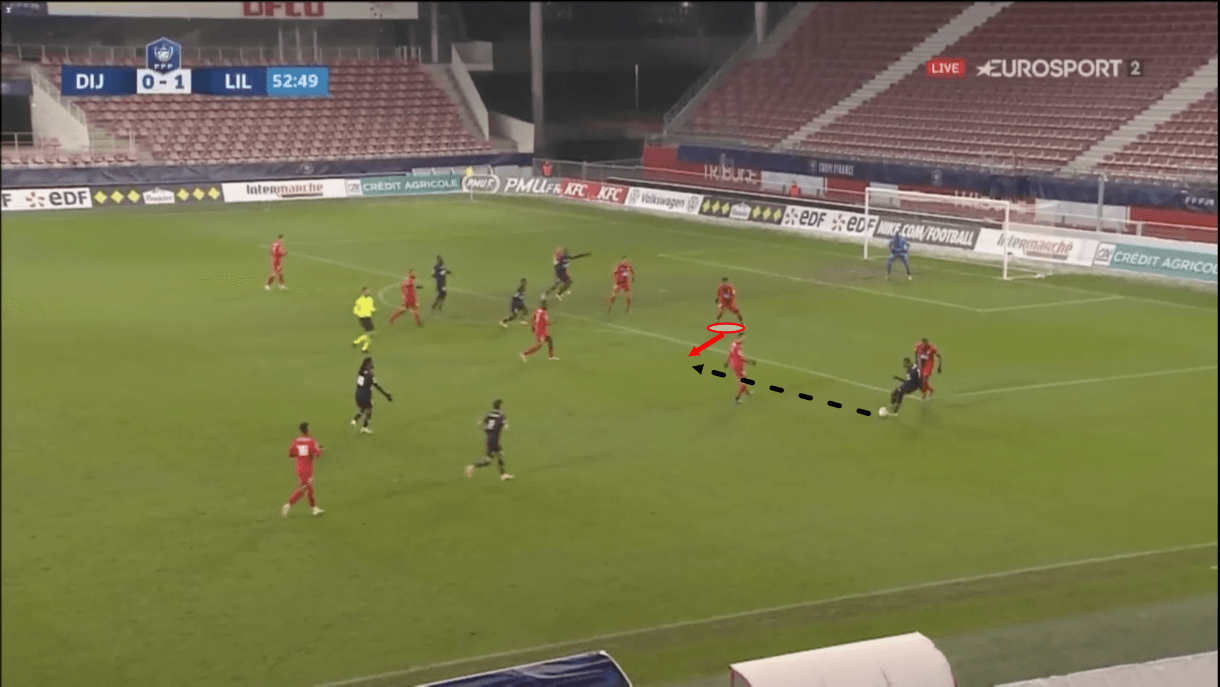
As the play moves on, Bamba quickly cuts inside and attempts to play the ball to his teammate on the edge of the box, while Panzo had dropped deep, anticipating this player to make a run in between him and his central defensive partner.
However, Panzo was quick to react to Bamba’s movements and managed to spring into action as soon as he cut inside and shaped up for this pass.
Following this image, the Englishman managed to get in front of the intended ball-receiver, cut off the passing lane and comfortably win possession back for Dijon.
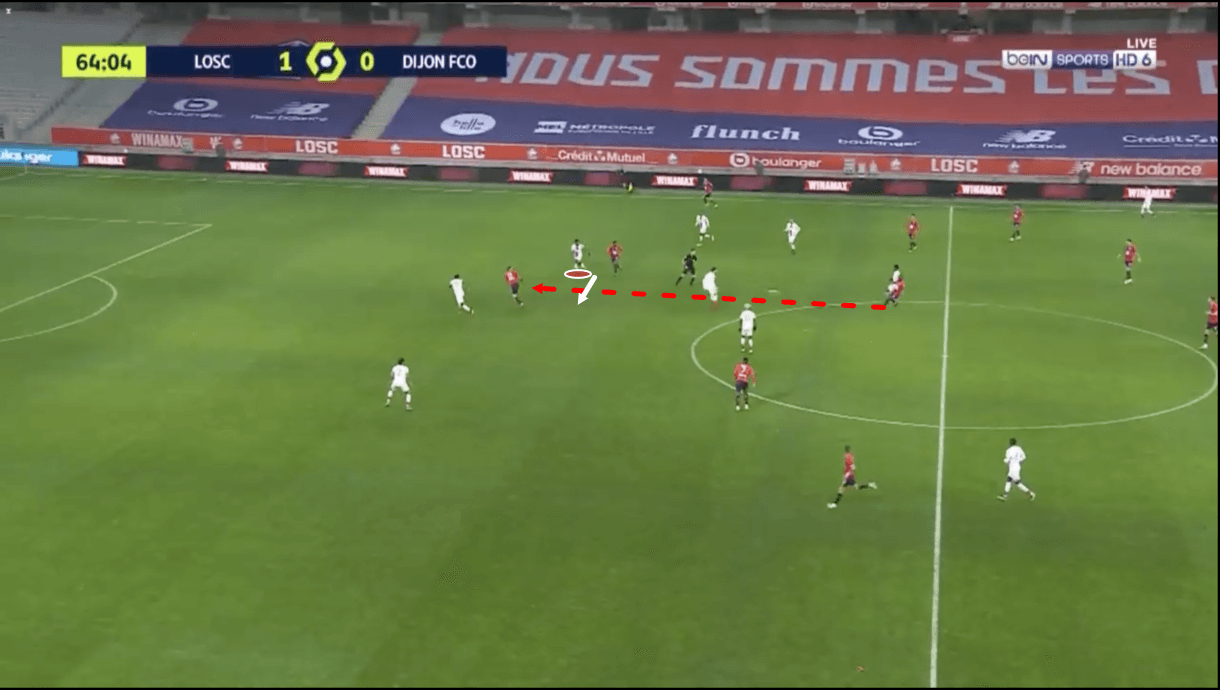
Another example of Panzo’s game-reading quality coming to his side’s aide can be seen in this next passage of play. In the image above, the opposition midfielder has played a through ball, aiming for the runner who is being tracked by Panzo’s central defensive partner and who is already positioned beyond the 20-year-old Englishman, who is occupied with another player.
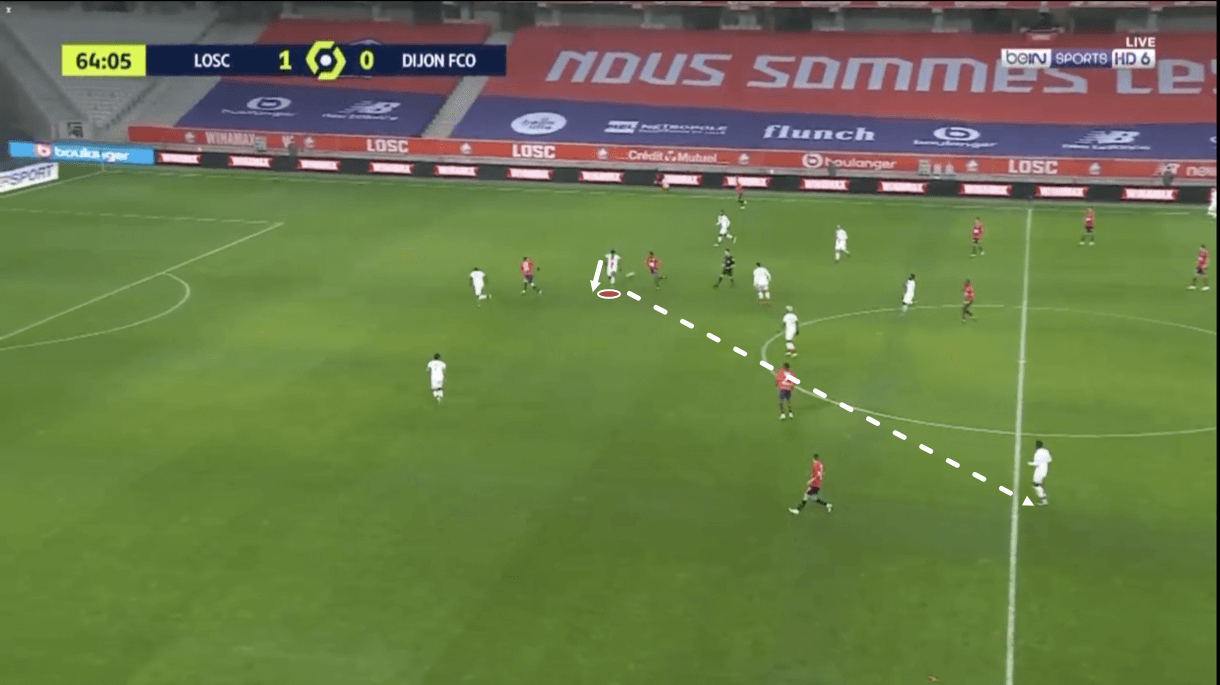
As the play moves on, however, Panzo reacts to this threat by shifting across the pitch and repositioning himself in the path of the through ball.
As he does so, he manages to stretch out and pull off this interception, clearing the ball upfield and into the path of a teammate.
So, these phases of play show us clear examples of Panzo’s ability to read the game, decision-making quality and speedy reactions, which have played a pivotal role in helping the defender to make so many interceptions, like the ones we’ve displayed here, for Dijon this season.
In addition to being an intelligent reader of the game, it would be fair to describe Panzo as quite a calm and patient defender. As a result, he hasn’t engaged in a huge number of defensive duels this season.
Dijon have engaged in the seventh-highest number of defensive duels per 90 (68.85) of any Ligue 1 side this term, however, 12 Dijon players have engaged in more defensive duels than Panzo has engaged (7.02) per 90 in the 2020/21 Ligue 1 season.
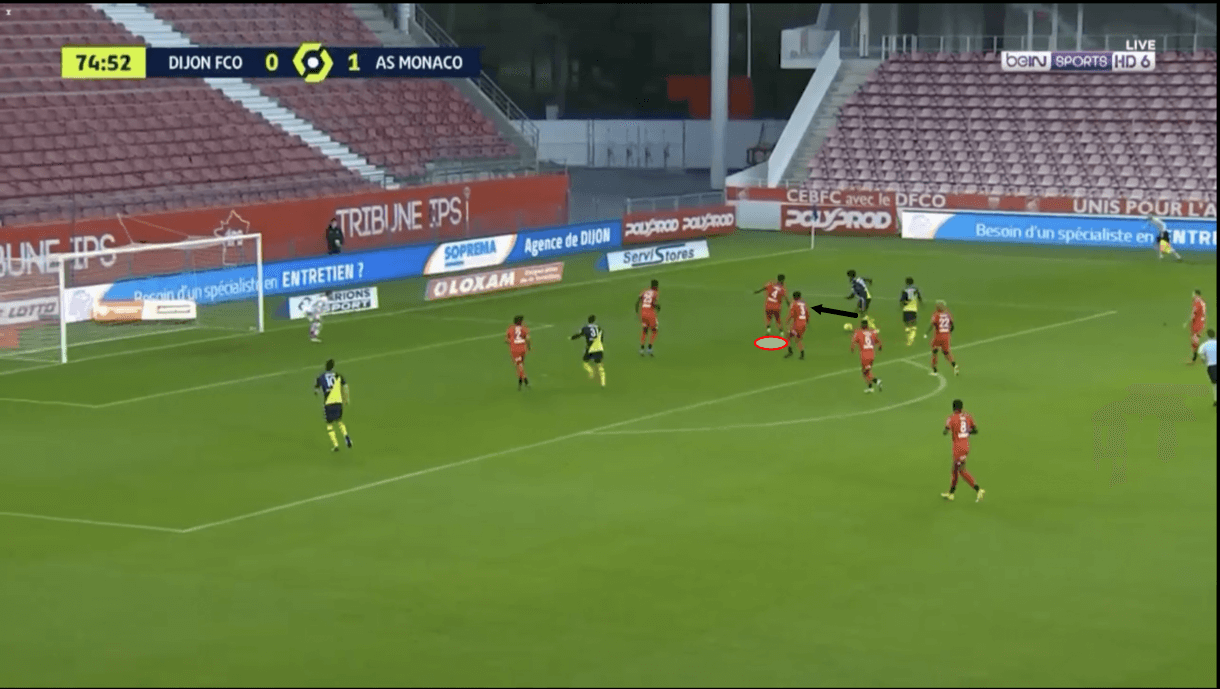
Panzo uses his game-reading quality, once again, to help him succeed in close-quarters engagements and avoid committing to defensive duels. Instead of his tackling, he tends to rely on his positioning and reactions to prevent opposition attackers from hurting his side in scenarios like the one he finds himself in, in the image above.
Here, Panzo was in action against his former club, Monaco, and in a close-quarters engagement with one Monaco attacker inside the penalty area. However, Panzo remains cool in situations like this and deals with the threat accordingly.
Panzo keeps himself positioned between this attacker and the goal, as well as the passing lanes into the other opposition attackers in the penalty area. He also remains close enough to the attacker to prevent him from enjoying too much space, but he also makes sure to keep enough distance between himself and the attacker so that he doesn’t end up committing himself to a challenge.
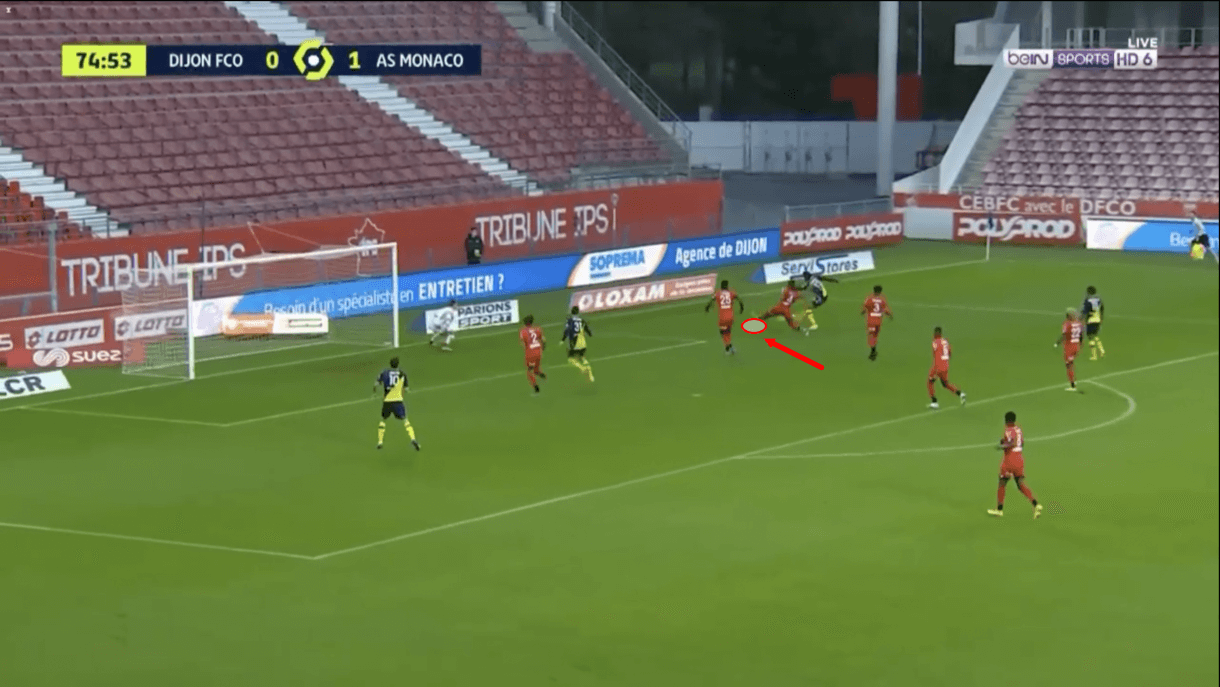
The next image above shows us how this passage of play progresses. Panzo essentially shepherds the ball-carrier down the line, keeping himself positioned between him and the goal/his teammates in the box. Eventually, the opposition attacker is forced into a decision and as he plays the ball, Panzo’s speedy reactions come into play, and he blocks the attacker’s shot/cross.
So, we can see from this passage of play how Panzo defends effectively in a calm manner, generally opting not to dive into tackles, but to rely on his positioning, reactions and ability to read the game as his primary defensive tools in close-quarters engagements instead.
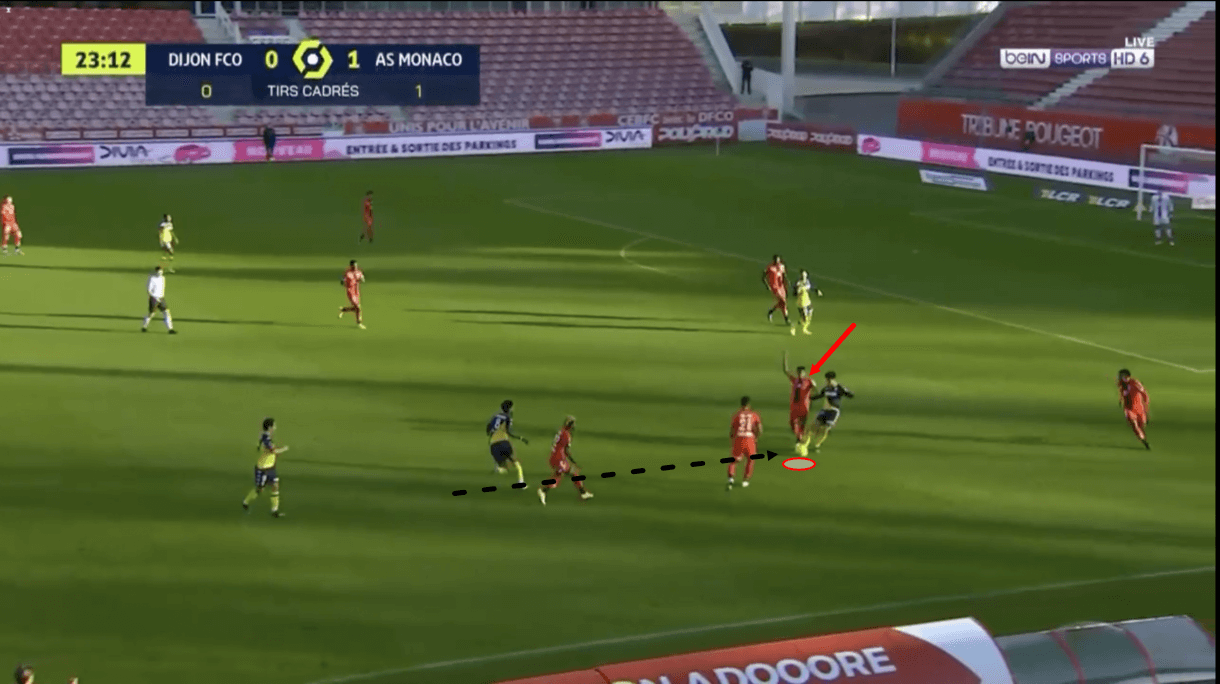
The previous passage of play showed us how Panzo typically deals with defensive 1v1s without committing to a defensive duel. This next image above shows us one example of the type of scenario in which Panzo does tend to engage in defensive duels, however.
Here, we can see that the centre-back has left his normal position in the back-four to approach an opposition player far more aggressively than normal from behind.
Just before this image was taken, a pass was played into the feet of this opposition player, who was facing away from Dijon’s goal, as he still is here as he waits to receive the ball.
While Panzo generally defends with a lot of patience and doesn’t dive into challenges, we see him engage opposition attackers fairly often in situations like this, where he decides that he has a good chance of coming out of the defensive duel successfully – likely because the opposition player doesn’t see him approaching from behind and so, he backs himself to quickly sneak in from behind and stop these types of attacks in their tracks.
A lot of the defensive duels he does contest come in situations like this and as his defensive duel success rate is 69.7% – the 27th-highest defensive duel success rate of any player in France’s top-flight – it’s difficult to fault this decision.
This defensive duel success rate shows us that while Panzo doesn’t engage in many defensive duels, he’s quite effective at them and he comes out on top a lot of the time when he does contest defensive duels.
His approach to defensive duels like the one we see him contesting in the image above relies on his reactions and his decision-making, and as he’s got a good track record of succeeding in defensive duels, this may once again show that he is impressing in those particular departments.
Moving onto Panzo’s pace and ability to cover opposition runners moving in behind the defensive line, we feel that this is a relatively weak area of the defender’s game, though not a glaring problem.
If a pacey attacker is played through on goal and given space to run into, Panzo will struggle to keep up with them, and there’s a good chance that the attacker will end up in a 1v1 with the goalkeeper, however, if an attacker isn’t played directly through on goal and instead is played through at an angle or if the runner isn’t particularly quick, Panzo has shown that he is capable of coping with them.
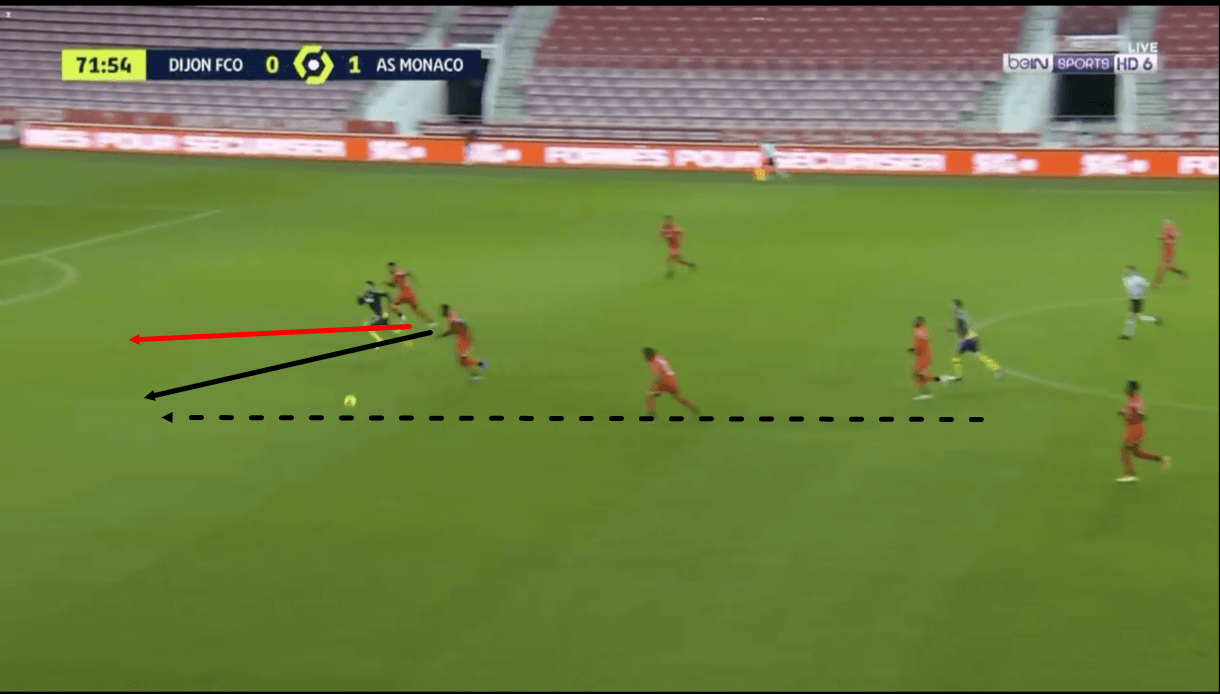
The image above shows us an example of a scenario where Panzo was capable of dealing with an opposition attacker being played in behind Dijon’s defensive line, however, as we can see, the ball is being played at an angle that forces the forward to make his run away from goal and allows Panzo to make up for having less pace than the attacker by making a straighter run.
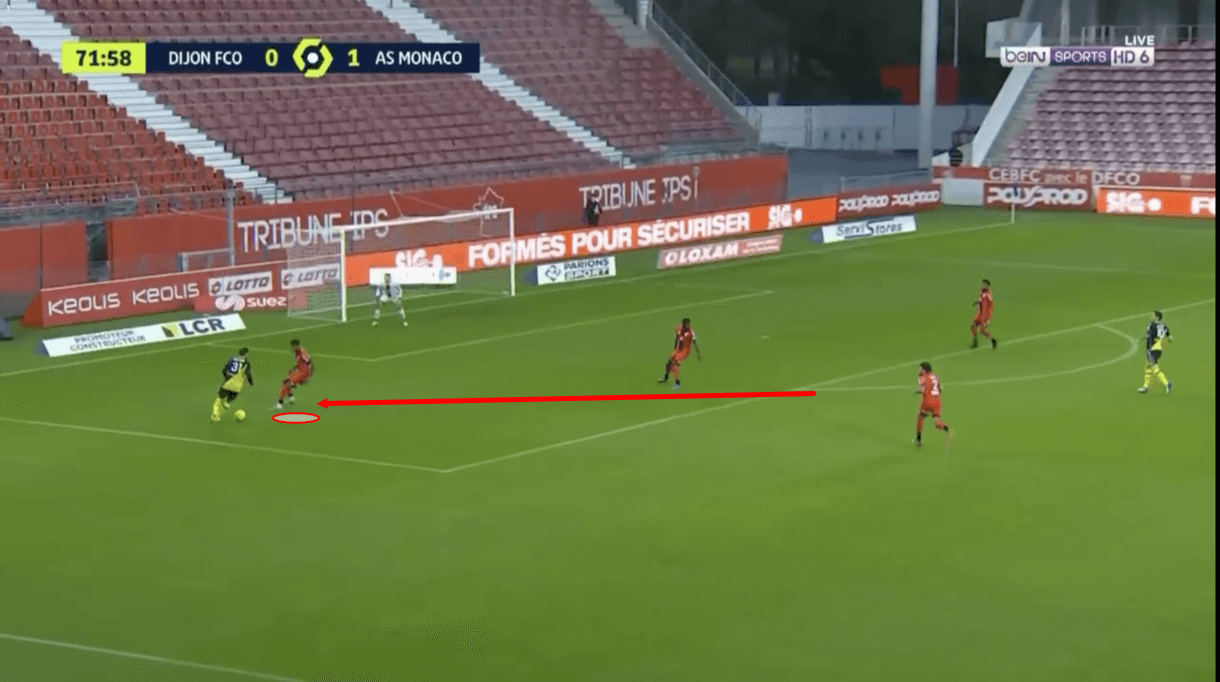
As this passage of play moves on, we see that Panzo was capable of stifling the attacker long enough that some of his teammates managed to get back and provide support and this led to the Monaco attack fizzling out and a Dijon counter-attack beginning.
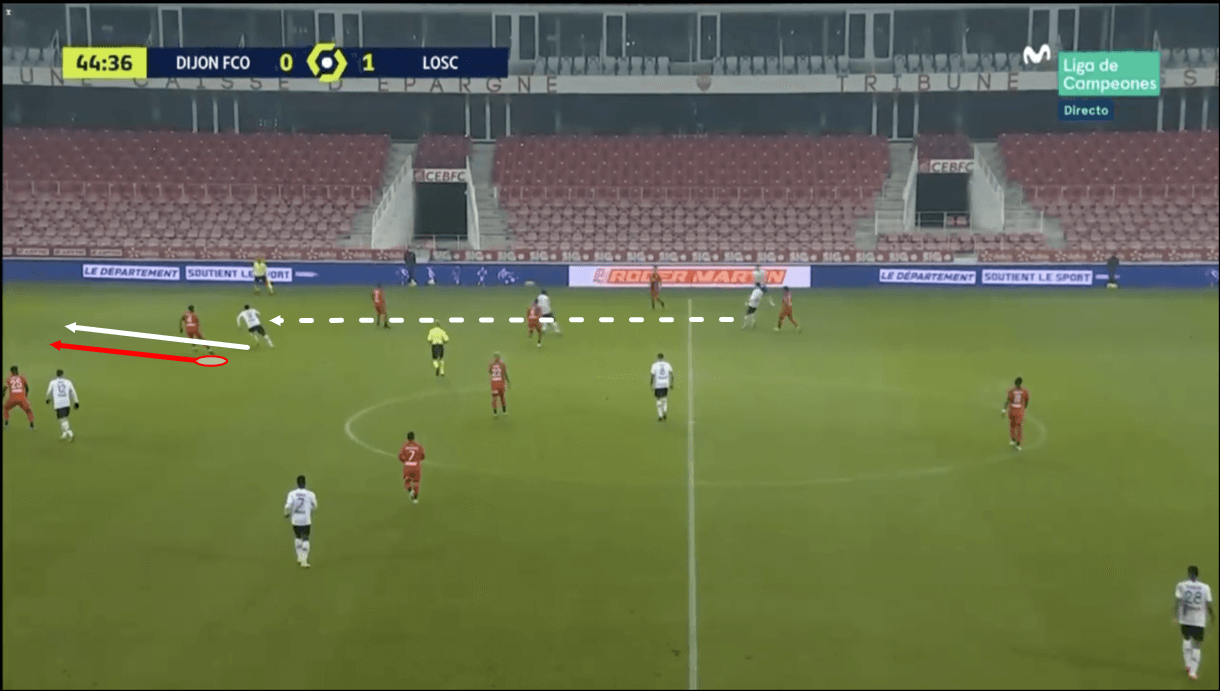
However, this next passage of play will show us how Panzo’s speed can be exploited. Here, we can see an attacker beginning to make a run in behind as a through ball is sent from just inside the opposition’s half.
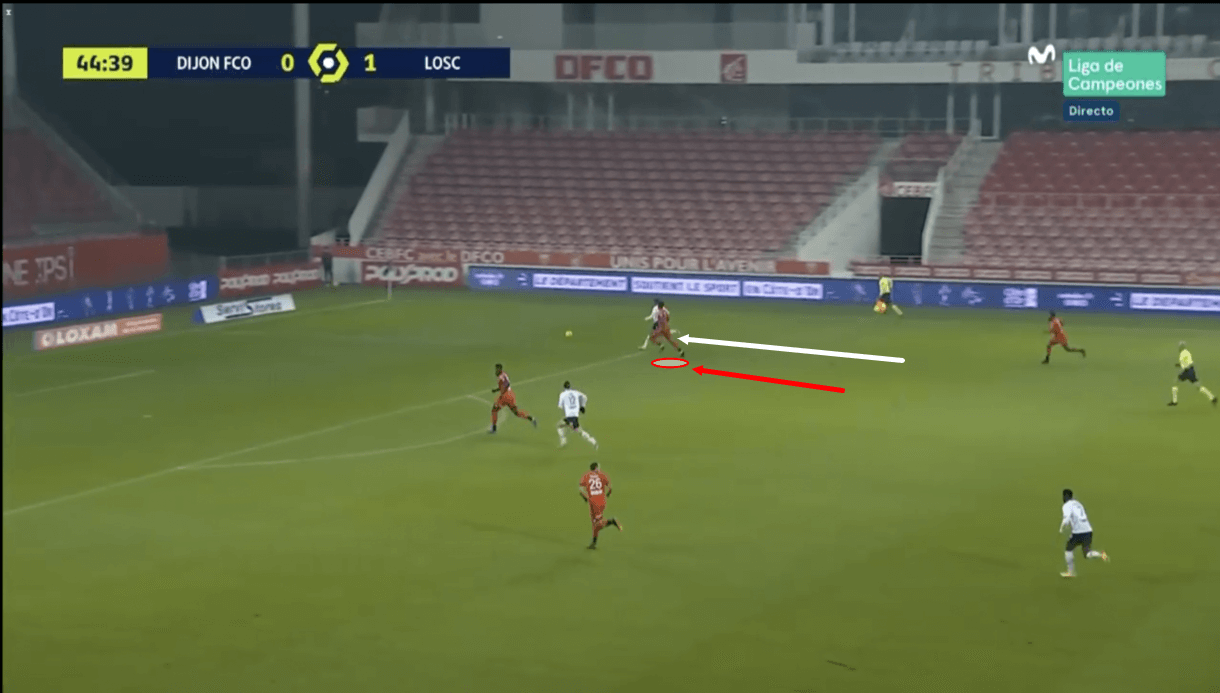
The attacker was not already past Panzo when the through ball was played, however, as this next image shows us, he managed to fly past him as the pair of players chased after this through ball.
On this occasion, Panzo couldn’t angle his run much differently to the attacker and he was well beaten in the straight-up sprinting contest.
He did benefit from the fact that the ball was played down the wing, as opposed to straight through the centre of the pitch towards the goal on this particular occasion, as it prevented a 1v1 between the Lille attacker and Dijon’s goalkeeper from being created, however, had the ball been played towards the goal, this would likely have happened and there’s little that Panzo could’ve done about it as he’d have been beaten for pace, so this is an area of his game that can be exploited.
Panzo is excellent at defending 1v1 and containing attackers, however, he struggles to defend against attackers when they have space to run into. He relies on his reactions and his reading of the game to cut out through balls like the one that was played here before the attacker can run in behind to prevent this area of his game from being exploited, as when the ball is played in behind, he struggles more.
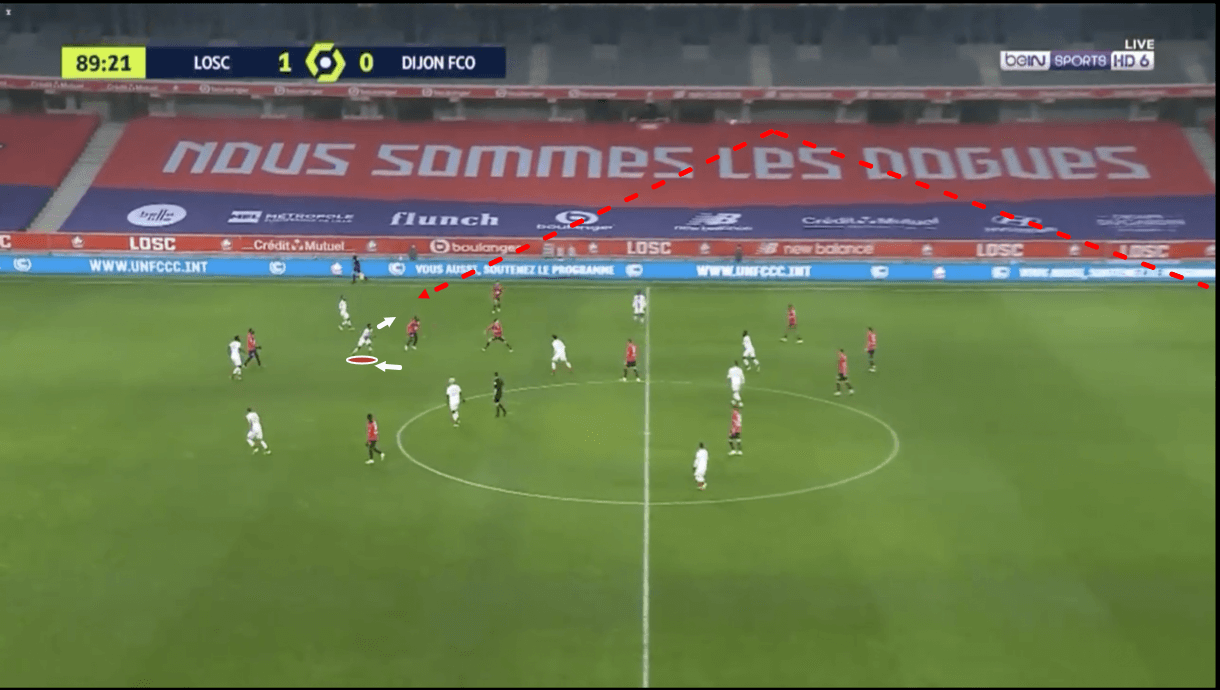
Lastly, as for aerial duels, Panzo is fairly reliable. He doesn’t contest an incredibly large amount of aerial duels, but from those he has contested – 3.83 per 90 – he has come out successful from 57.41%, which is a respectable number.
The image above shows an example of Panzo readying himself to engage in an aerial duel from an opposition kick out. As he watches the flight of the ball, attempting to time his jump, he takes a step back, creating some distance between himself and the opposition player. This is a fairly common movement to see him make just before entering an aerial duel, as it allows him some space to enjoy a run-up, giving him a boost when approaching the opposition player.
This helps Panzo to get above the Lille man with his jump, win the aerial duel and send the ball towards Dijon’s attackers.
It’s important to note, however, that Panzo isn’t an incredibly physical player and while he has done relatively well in aerial duels this season, plenty of larger, more physically imposing centre-backs have done much better, so this area of his game is not a glowing strength, even if his reading of the game and intelligent approach to these situations can give him a hand.
Panzo’s passing
Panzo has impressed with his ability on the ball, as well as his ability off the ball, this term. Per Wyscout, The 20-year-old has played the second-most passes of any Dijon player in Ligue 1 this season (48.16) while retaining the second-best pass accuracy percentage (90.72%) of any Dijon player.
The Englishman has played an average of 54.07 passes per 90 in all competitions this term, with 18.32 of those passes being played forward, while 84.5% of his forward passes have been accurate, which isn’t a very significant drop-off from his overall pass accuracy percentage, indicating that his forward passing success is quite consistent with his backward/lateral passing success, despite the added risk that comes with playing the ball towards the opposition goal.
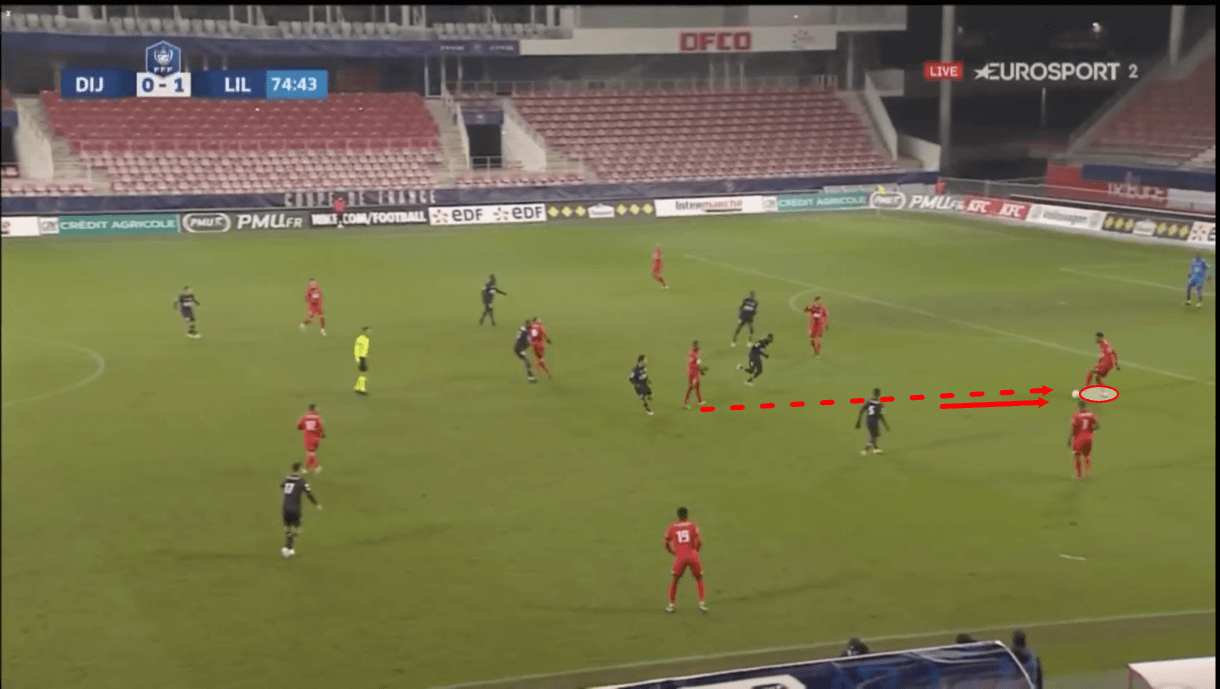
As the image above shows, a lot of the time when receiving the ball, Panzo likes to take a couple of steps backwards, which places him slightly behind the rest of the backline. By doing this, he increases the distance between himself and the opposition players who might try to dispossess him, increasing his time to make a decision on the ball. Additionally, stepping back like this increases the centre-back’s field of vision, allowing him to scan more of the pitch before playing his pass.
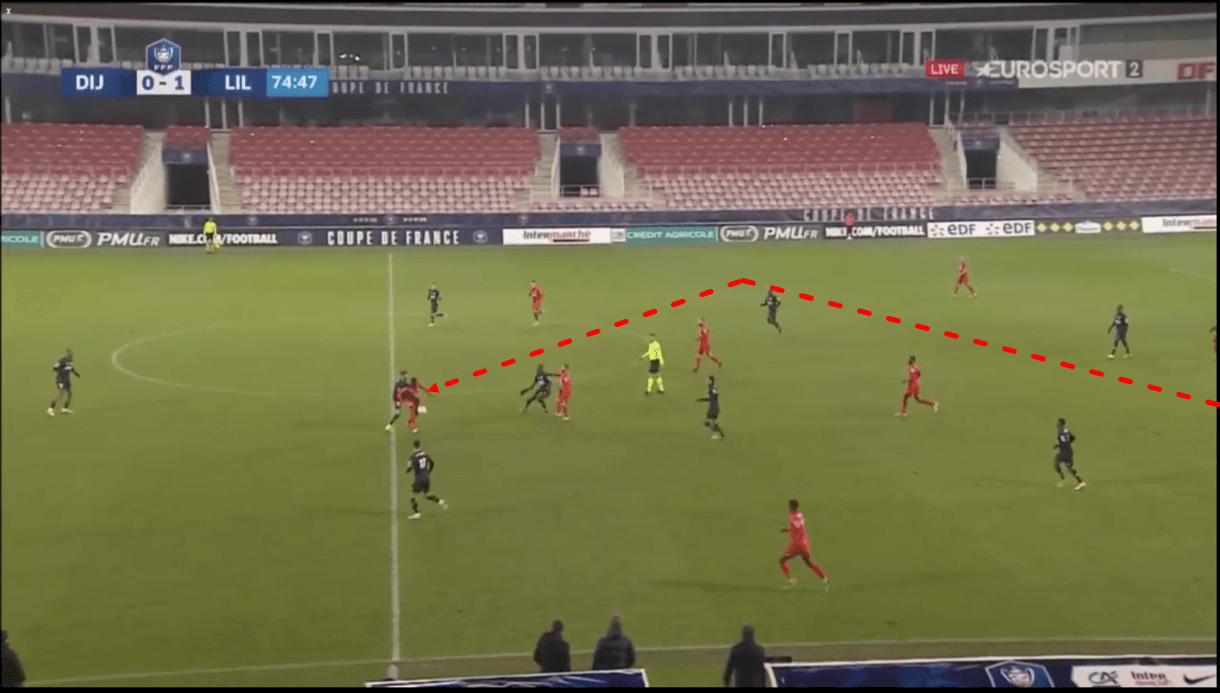
As this particular passage of play moves on, we see that Panzo sends the ball up to the centre-forward, who is looking to hold-up the play and bring other Dijon attackers into the fore.
A lot of the time when Panzo plays long-balls, he likes to link up with the centre-forward like this. The centre-back aims to play the ball in such a way that the striker can take the ball down and hold-up the play, rather than play the ball ahead of the striker for them to run onto and get in behind.
As a result, Panzo’s long passing accuracy is vital and he’s demonstrated that he’s capable of consistently hitting the target with long-balls like this, which is helpful for his side when building attacks.
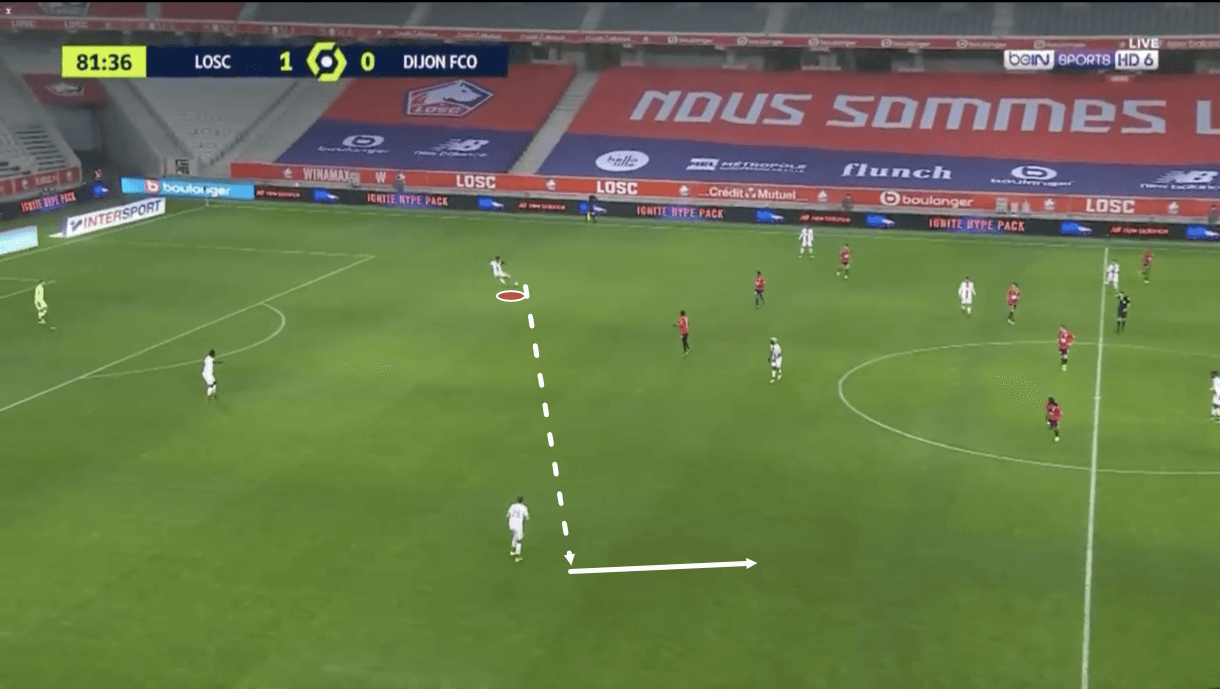
This next image shows us an example of another type of pass that Panzo typically likes to play. When not playing the ball up to the centre-forward, he likes to play passes across the field to the right-back.
It’s fairly common to see Panzo pull off this particular pass when playing against a narrow side, as quickly switching the play like this can see the right-back take advantage of the space afforded to him by the opposition’s narrow structure to carry the ball forward for Dijon.
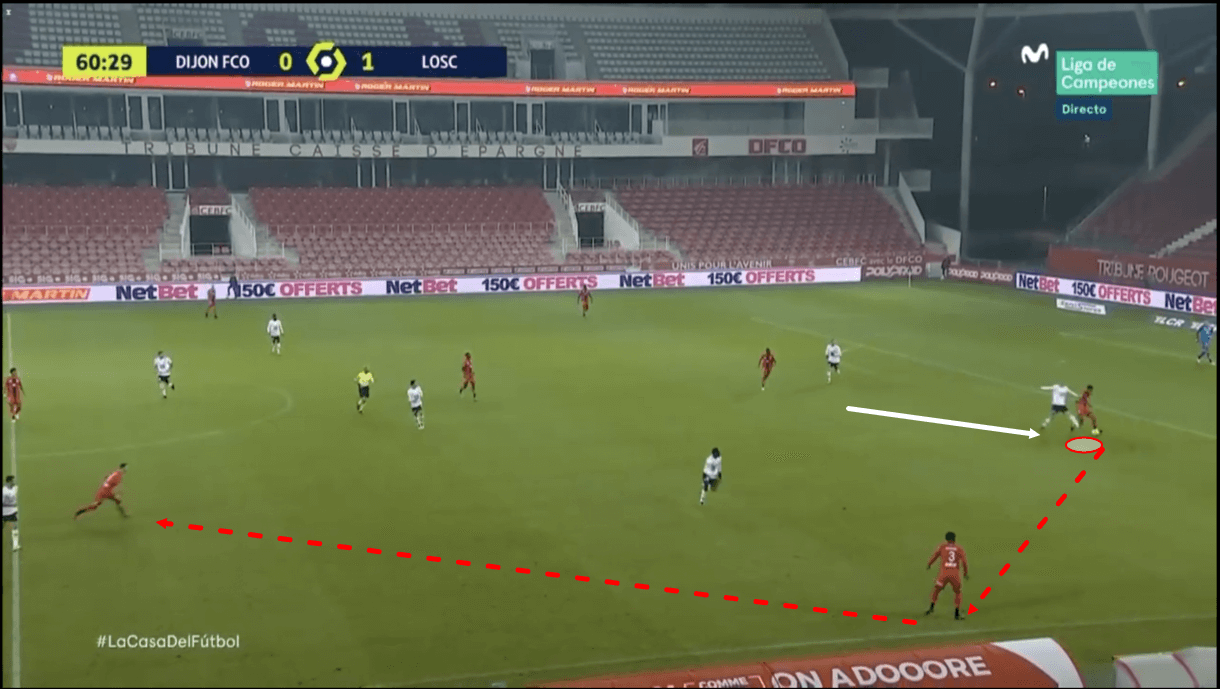
Panzo has also proven to be quite calm under pressure when playing out from the back. Just before this next image above was taken, Panzo received the ball from the right centre-back. As he controlled the pass, the Lille striker pressed him from the inside, preventing him from playing the ball back to the right centre-back or into central midfield.
Despite being pressed quite aggressively and having some of his passing options cut off, however, Panzo remained calm and took all of the time that he had on the ball – allowing the opposition attacker to get quite close, as we can see – before he played the pass out to the left-back, who subsequently played the ball upfield himself.
So, we can see that Panzo was not rushed or forced into an error by this pressure, which is quite typical of him and his character on the pitch. On and off the ball, Panzo exudes a sense of coolness. He always feels like he’s in control of the situation and his self-confidence, as well as his technical ability, both defensively and offensively, may play a large role in that.
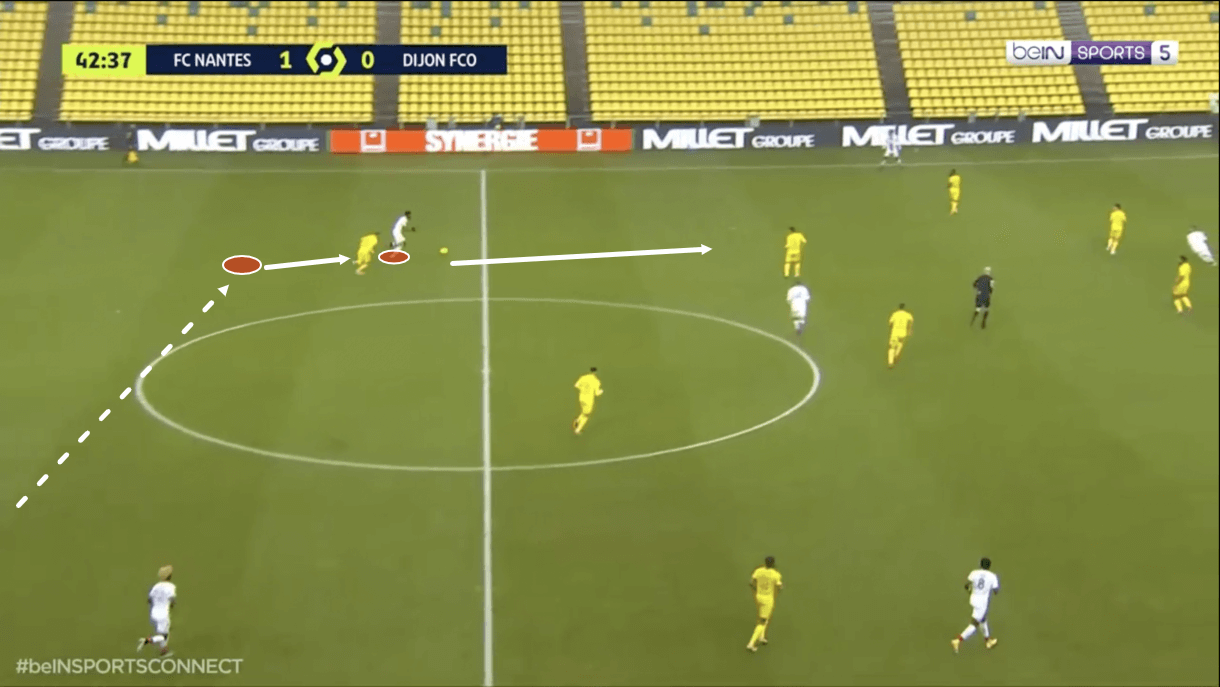
Lastly, Panzo doesn’t just take steps back and play long-balls to progress the play for his side, he also carries the ball upfield to break the first line of pressure somewhat regularly, as this image above shows us.
Panzo tends to back his ability on the ball. His technical quality, combined with the mental traits that we just touched on, mean that he is comfortable with drawing some pressure and carrying the ball upfield, past the players who approach him, as was the case in this particular passage of play.
Just before this image was taken, Panzo received the ball from the right centre-back. He allowed the ball to move across his body before taking his first touch, which was a fairly heavy touch and saw him move the ball past this striker, who he then continued to dribble past to carry the ball into the opposition’s half.
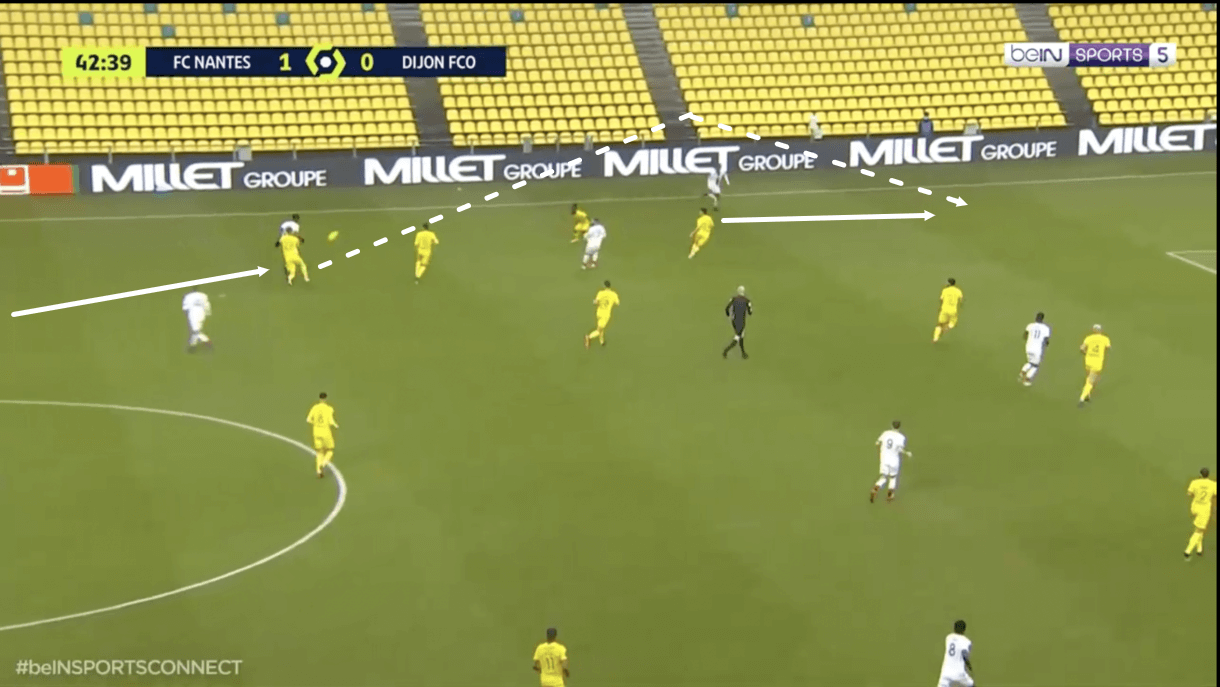
Jo
As the play moves on, Panzo ends up carrying the ball a considerable distance into the opposition half, almost into the final third. As he does so, he attracts pressure from more players and this allows the overlapping Dijon left-back to find some space out on the left-wing. As he makes his run, Panzo lifts the ball over the top for the left-back to run onto.
This passage of play shows us that Panzo is not just an accurate long passer, but an effective ball-carrier and someone who can act as a deep playmaker.
Conclusion
To conclude this scout report, we feel that Panzo has shown that he is an all-around good centre-back this season when he’s been given the chance to show what he can do with Dijon. His standout traits are his ability to read the game, his defensive positioning, decision-making and his ball-progressing quality.
Outside of those standout traits, he has also shown that he is capable of performing to a reasonable standard in the air and while he’s not an incredibly aggressive defender, he has been very effective on the relatively rare occasions when he has decided to engage attackers in defensive duels.
As for his weaknesses, Panzo has been beaten for pace by speedy opposition attackers and while this hasn’t been a major issue, it is something that could cause problems for his team, meanwhile, although he’s a fairly good size, he’s not a great physical presence by any means and could be outmuscled, so Panzo’s physical traits could do with some work, however, he is mentally and technically a good, reliable player and could be one to keep in mind for an upper-level second-tier/lower-level first-tier side from his home country, England.





Comments